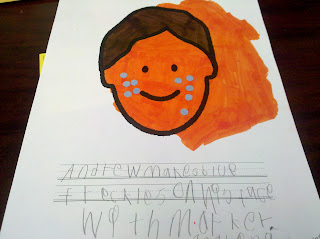After reading the book Out of My Mind by Sharon Draper, I couldn't help but wonder...
What are my students thinking that they can't express to me?
Is our content watered down? Are they wondering why we are learning similar concepts year after year, sometimes with the same trade book, the same Brain Pop Jr. video, the same SMARTboard lesson?
What have my third graders been trying to show me, or tell me, that I haven't been listening to? Have I challenged them enough?
And so...
We started a new adventure.
Chapter books.
Chapter Book #1- Freckle Juice by Judy Blume.
I wasn't fully prepared, but I was ready to learn as we went along. I figured the kids would show me what they needed and I would adjust as we went along. We started with predictions, a picture walk, an explanation of what a chapter book is, a reminder of what authors do, and how famous an author Judy Blume really is. Homework included "Googling" Judy Blume and writing down other book titles and also rereading the chapters we read during the school day.
We also began to fill out a graphic organizer on EDU Glogster which can be found here- http://morgank18.glogster.com/frecklejuice-graphic-organizer/
Then, as we read the first chapter and I prompted my friends to have "listening ears," to "keep listening," and to "listen for two more pages," I realized that perhaps we needed more visuals. Why didn't this occur to me earlier? I know my students are visual learners, they need visuals, right? Yep.
This prompted us to create "notebooks." We added pictures as we read each chapter to make the reading come to life, visually. We also visually defined the characters, the setting, and some vocabulary.



We also decided that, after reading these short chapters, we should take smaller comprehension quizzes, rather than a summative quiz at the end of the book. The quizzes were also visually based, using most of the same visuals created for our "notebooks."
Then, we started adding to our e-portfolios.
We added "Wordles" and some "Thinking Stems" that we wrote together in class, then typed individually.
As a final project, we created simple "portraits" of the main character, Andrew.
Lastly, we created a file folder to put in our "Independent Work" area to be able to maintain the vocabulary words we learned with this chapter book.
All in all, I think I learned some valuable lessons from my third graders with autism and Down syndrome here.
First, USE VISUALS.
Second, REREAD AND REREAD AGAIN.
Third, REVIEW NEW VOCABULARY REPEATEDLY.
Fourth, THEY CAN DO IT!!!
Hooooooray for us! We'll next be venturing into reading a chapter book on the Kindle for iPad App. Wish us luck:?
What are my students thinking that they can't express to me?
Is our content watered down? Are they wondering why we are learning similar concepts year after year, sometimes with the same trade book, the same Brain Pop Jr. video, the same SMARTboard lesson?
What have my third graders been trying to show me, or tell me, that I haven't been listening to? Have I challenged them enough?
And so...
We started a new adventure.
Chapter books.
Chapter Book #1- Freckle Juice by Judy Blume.
I wasn't fully prepared, but I was ready to learn as we went along. I figured the kids would show me what they needed and I would adjust as we went along. We started with predictions, a picture walk, an explanation of what a chapter book is, a reminder of what authors do, and how famous an author Judy Blume really is. Homework included "Googling" Judy Blume and writing down other book titles and also rereading the chapters we read during the school day.
We also began to fill out a graphic organizer on EDU Glogster which can be found here- http://morgank18.glogster.com/frecklejuice-graphic-organizer/
Then, as we read the first chapter and I prompted my friends to have "listening ears," to "keep listening," and to "listen for two more pages," I realized that perhaps we needed more visuals. Why didn't this occur to me earlier? I know my students are visual learners, they need visuals, right? Yep.
This prompted us to create "notebooks." We added pictures as we read each chapter to make the reading come to life, visually. We also visually defined the characters, the setting, and some vocabulary.



We also decided that, after reading these short chapters, we should take smaller comprehension quizzes, rather than a summative quiz at the end of the book. The quizzes were also visually based, using most of the same visuals created for our "notebooks."
Then, we started adding to our e-portfolios.
We added "Wordles" and some "Thinking Stems" that we wrote together in class, then typed individually.
As a final project, we created simple "portraits" of the main character, Andrew.
Lastly, we created a file folder to put in our "Independent Work" area to be able to maintain the vocabulary words we learned with this chapter book.
All in all, I think I learned some valuable lessons from my third graders with autism and Down syndrome here.
First, USE VISUALS.
Second, REREAD AND REREAD AGAIN.
Third, REVIEW NEW VOCABULARY REPEATEDLY.
Fourth, THEY CAN DO IT!!!
Hooooooray for us! We'll next be venturing into reading a chapter book on the Kindle for iPad App. Wish us luck:?



















